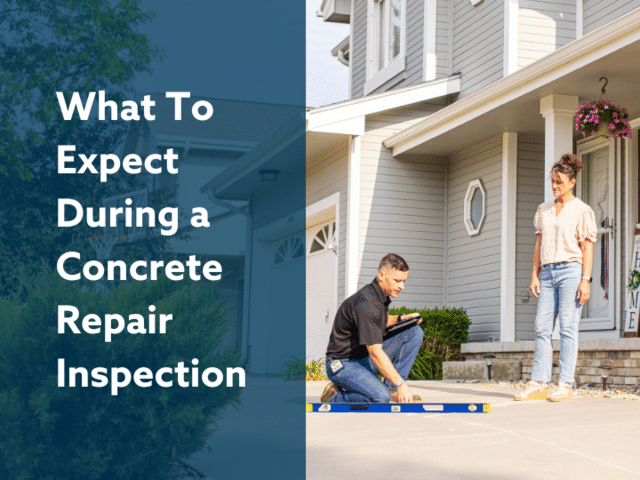The Best Way To Fix Concrete Steps That Have Pulled Away

Concrete steps are essential features of your home, offering both function and curb appeal.
But when they start pulling away from the house, it’s not just a cosmetic issue—it’s a safety concern. Uneven steps can cause trips and falls, putting your family or guests at risk.
When faced with this problem, it’s natural to turn to Google for quick DIY fixes, but when does a simple repair job turn into something that requires a professional solution? Let’s explore why concrete steps pull away, why DIY fixes are risky, and how professionals can resolve the problem for good.
Why are my concrete steps pulling away?

Soil dryout affecting concrete
The most common reason for concrete steps pulling away from a house is soil movement. Soil plays a major role in the stability of your home’s foundation and any attached structures. Here’s how.
-
Dry spells and droughts: During periods of drought, the soil around your home dries out, shrinks, and creates gaps beneath the concrete steps. This lack of support causes the concrete to shift, sink, or pull away from the house.
-
Heavy rain and erosion: When heavy rain returns after dry conditions, it doesn’t soak into the soil as usual. Instead, it flows through the gaps created during the dry season, causing soil erosion. This further destabilizes the foundation supporting your steps. Over time, this ongoing cycle of soil drying, shrinking, and rehydrating weakens the structure, causing the steps to pull away.
Soil movement, especially when combined with poor installation or lack of proper drainage, can lead to significant issues that compromise both safety and stability.
Can I DIY fix my concrete steps?

When homeowners notice their concrete steps pulling away, many turn to Google, Reddit, or even TikTok for DIY solutions. While these fixes might seem quick and cost-effective at first, they often lead to more significant problems down the line. Here’s why:
-
Addressing symptoms, not the cause: The biggest issue with DIY repairs is that they usually address the visible problem but not the root cause. Filling the gap with concrete or caulk may temporarily fix the appearance, but it won’t resolve underlying soil erosion or foundation movement. As a result, the issue will likely return, often worse than before.
-
Higher costs in the long run: While DIY solutions might seem cheaper upfront, they can lead to increased repair costs over time. As the steps continue to pull away, they can cause damage to surrounding concrete, create new tripping hazards, and even require full replacement.
-
Safety hazards: Misaligned or damaged steps are serious safety hazards. A simple trip can lead to injury, turning what might seem like a minor repair into a major liability. It’s easy to overlook the danger until an accident happens.
Are damaged concrete steps a sign of foundation problems?
In some cases, pulling concrete steps could signal a larger issue—such as foundation problems. If your foundation is sinking or your walls are failing, the steps may be one of the first symptoms. To assess whether your foundation might be the issue, look for cracks inside and outside of your home, particularly around the area where the steps are located. If you see cracks in walls, floors, or the foundation itself, it’s time to consult a professional to evaluate the situation.
Why you should trust the professionals to repair your concrete steps
While DIY repairs might seem tempting, fixing your concrete steps is usually best left to the professionals. Here's why.
-
The root cause will be addressed. Concrete step issues are often just a symptom of a larger problem. We will identify the underlying cause and address it to prevent the problem from recurring.
-
It requires special techniques and tools. At Thrasher Foundation Repair, we use specialized methods like polyurethane foam injections to stabilize and lift concrete steps back into place. These advanced techniques not only improve the appearance but also fix the underlying issues, ensuring a long-lasting repair.
-
It prevents further damage. Improper DIY repairs can cause more extensive damage to your home over time, ultimately costing you more. Our solutions ensure that your steps, foundation, and surrounding structures remain stable and safe for years to come.




How to fix concrete steps that pulled away
As mentioned, here at Thrasher, we use polyurethane foam injections to fix concrete steps that have pulled away. But what is polyurethane foam and how does it work?
Polyurethane foam works by injecting this foam beneath sinking or cracked concrete through small dime sized ports. The foam flows like water to fill cracks and voids, then expands and hardens, lifting the slab and compressing the surrounding soils. It cures quickly, allowing most concrete to be usable the same day. The system is waterproof, eco-friendly, and won’t wash out, dry out, or degrade over time due to temperature changes.
At Thrasher Foundation Repair, we understand that pulling concrete steps aren’t just an inconvenience—they’re often a sign of bigger issues. Our team of experts can inspect your concrete steps and provide a solution tailored to your needs. We offer free inspections and same-day quotes, so don’t wait for the problem to get worse. You can reach out to us by calling us at 1-800-827-0702, filling out the form below, or starting a chat in the bottom right-hand corner.
Schedule Your Free Inspection Online In Minutes
Meet with a trusted expert, and get clear answers about your home.
Article Categories:



